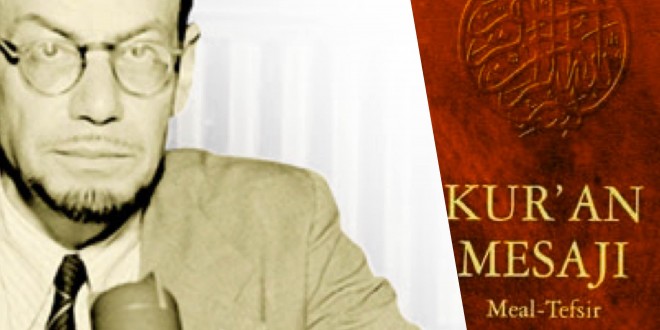Esed, sekiz sayfalık önsözünde Kur’an tefsiri hakkındaki görüşlerini bildirmiş, metodunu özlü bir biçimde ifade etmiştir. Sıradan bir tercüme veya tefsir yapmamış, yirminci yüzyılın kültürüyle yetişmiş bir insanın Kur’an’a bakışını, ondan istifadeye çalışmasını, ona sorular sorup ondan gelecek cevapları arayışını ortaya koymuştur. O, Kur’an’ın insanlık tarihinde gerçekleştirdiği inkılaba değinip onun Batı’da layıkıyla değerlendirilememesinin sebeplerini tahlil eder. Batılılarca yapılan Kur’an tercümelerinin “kasıtlı olarak saptırıldığı” şeklindeki kolaycı iddiaya yer vermeyip meselenin temelindeki zihniyet farkını bulmaya çalışır. Yaşı otuza yaklaştığı bir sırada Müslüman olduktan sonra altmış beş yıl kadar daha süren bereketli bir hayat geçirmiş olan müellifimiz tefsirini ömrünün son döneminde kaleme almıştır. Arapçayı çok iyi derecede öğrenmiş, önsözünde listesini verdiği kaynaklardan yararlanmakla beraber kendi bilimsel şahsiyetini devamlı surette muhafaza ettiğini yaptığı açıklamalarla hep göstermiştir. Bu eserin entelektüel beklentileri tatmin eden meziyetini, hatta bazan tefsir ilmine faydalı katkılar sağlayabilecek açıklamalar yaptığını bizzat gözlemlediğimi açıkça belirtiyor ve onun bu faziletini kabul ediyorum. Fakat bunun yanında, Sünnî müfessirlerin tefsirlerine aykırı olan hatalı bulduğumuz yorumlarına temas etmeyi de bir sorumluluk olarak görüyorum.
Şunu da tasrih edeyim ki yazarın sonradan Müslüman olması sebebiyle içimde en ufak bir şüphe bulunmuyor. Aksine böyle olmasını İslam kültürüne faydalı bir katkı saydığım gibi onun sağlam bir Müslüman olduğuna dair tam bir hüsnüzan içinde bulunuyorum. Fakat kendisi, diğer müfessirlerden, bilinçli tercihi ile ayrılırken “Onların yorumlarından ayrıldığım zaman bile, gerçeği bulma yolunda bana güç katan bilgilerini takdirle karşıladım” dediği gibi, biz de kendisinin hatalı bulduğumuz yorumlarından ayrıldığımızı belirtmek istiyoruz. Böylece meziyetini bir asıl olarak toptan ifade ederken, az ve arızi olan yanlış bulduğumuz taraflarına dikkat çekmek istiyoruz. Burada toplumumuzda ortaya çıkan bir tezahüre de –yorumsuz olarak– yer vermek istiyoruz: Otuz yıl kadar önce, büyük bir alimin bir tarih kitabında sadece miraç konusundaki bir yorumu senelerce süren tepkilere yol açtığı halde, şimdi bir Kur’an tefsirinde onun onlarca misli olan teviller, sayısı hayli artmış olan ilim ehlinin kalemlerini harekete geçirmiyor. Dahası, bu tefsir kitabı, dindar çevreler tarafından yayılıyor. Doğrusu düşünmeye değer.
Merhum yazarımızın dikkat çeken özelliklerinden biri, bazı gaybi ve mucizevi meseleleri rasyonalist açıdan yorumlamaya çalışmasıdır. Bazı örnekler verelim: Ona göre miraç, fiziksel (bedenle) olmayıp rüyanın ötesinde ruhi bir tecrübedir. Bunun böyle olduğunu, İbn Kayyim el–Cevziyye’ye de dayandırmaya çalışarak, modern psikoloji verileriyle açıklamaya yönelir. A’raf, 166 ayetinde, zulüm ve azgınlıkları sebebiyle maymuna çevrildikleri bildirilenler hakkında, “Onların yalnız kalpleri maymuna dönüştürüldü, yani ruhen maymunlaştılar, bedenen değil. Bu, Allah’ın, onların durumunu tasvir etmek için irad ettiği bir meselden, bir benzetmeden başka bir şey değildir.” der.
Bakara Sûresi’nin 102. ayetinde Harut ile Marut’un öğretip bazı insanların da onlardan öğrendikleri nesne, müfessirlerce “sihir” şeklinde tefsir edilir. M. Esed’e göre ise sihir diye bir şey yoktur, burada öğrendikleri nesne, “karı ile koca arasında huzursuzluğun hangi yolla çıkarılacağıdır”. Aynı konuda Felak Sûresi’nin tefsirinde Zemahşeri, M. Abduh ve Reşid Rıza’ya dayanarak sihrin gerçekliğini reddeder ve “Açıkça akıl dışı bulunmalarına rağmen, müminin bu tür uygulamalardan Allah’a sığınmasının emredilmesinin sebebi, –Zemahşeri’ye göre– bu tür meşguliyetlerin günah oluşunda ve bununla uğraşanlar için zihinsel bir tehlike taşımasında yatmaktadır”. Nas Sûresi’nde sözü edilen cinler hakkında şöyle der: “Yukarıdaki bağlamda terim, muhtemelen insan bünyesinin karşı karşıya bulunduğu ve doğru ile eğri arasında ayrım yapmamızı zaman zaman güçleştiren görünmez, esrarlı tabiat güçlerini göstermektedir. Ancak Kur’an’ın son sûresinin bu son ayeti ışığında bakıldığında, kendilerinden Allah’a sığınmamız emr edilen ‘görünmez güçler’in, kendi kalplerimizin körlüğünden, ihtirasımızdan ve atalarımızdan bize geçen sakat anlayış ve batıl değerlerden kaynaklanan şeytanî eğilimler olduğu sonucuna varırız”. Bakara 14 ayetindeki “şeytanlar”ı, “Ama şeytani dürtüleriyle baş başa kaldıklarında ‘Aslında biz sizin yanınızdayız, onlarla sadece eğleniyoruz’ derler.” diyerek “şeytanî dürtüler” şeklinde açıklar. Fakat ayet, muhatapların “dürtüler” değil de “şeytanlar” olduğunu tasrih ettiğinden, buradaki yorum boşlukta kalmaktadır.
Müfessir, bu kadarla yetinmeyip rasyonalist yorumlamada daha ileri giderek bazı mucizeleri tevil eder. Bu cümleden olarak, Hz. Musa (as)’ın İsrailoğulları ile denizden geçmesi konusuna bakalım. O bu mucizeye değinen Bakara 50 ve Taha 77–78 ayetlerini yorumlamayıp Şuara Sûresi’nin tefsirinde bu konuyu ele alır ve şöyle der: “Tevrat’taki muhtelif atıflara bakılacak olursa (özellikle Çıkış, xıv,2 ve 9), Kızıl Deniz’i geçme mucizesi, bu denizin bugün Süveyş Kanalı olarak bilinen kuzeybatı ucunda vuku bulduğu anlaşılmaktadır. Kıssanın geçtiği çağlarda burası şimdiki kadar derin değildi ve bazı bakımlardan Kuzey Deniz’inin ana kıtayla Firisan adaları arasında kalan sığ bölümü gibiydi; yüksek cezir (geri çekilme) hallerinde bu gibi yerlerde sığ bölgeler çıplak kalmakta ve geçici olarak geçilebilir hale gelmekte; ama bu durumdayken, ani ve şiddetli bir med dalgasıyla bütünüyle sulara gömülmektedir”.
Kamer Sûresi’nin 1. ayetinde bildirilen “Ay’ın yarılması”nın kıyamet öncesinde olacağını, Hz. Peygamber (sas)’in hayatında Mekke’de iken bu yarılmanın gerçekleştiğine dair hadislerin “sübjektif gerçekliğinin” olabileceğini, muhtemelen alışılmamış kısmi bir ay tutulmasının söz konusu olabileceğini iddia eder .
Hz. İsa (as)’ın dünyaya geldiği sırada beşikte konuştuğunu bildiren: “Derken bebek: “Ben Allah’ın kuluyum” dedi. O, bana kitap verdi, beni peygamber olarak görevlendirdi” “Nerede olursam olayım beni kutlu kıldı. Yaşadığım müddetçe bana namazı ve zekâtı farz kıldı.” Meryem 30–32 ayetlerinde bildirilen sözlerini, Hz. İsa (as)’ın büyüdükten sonra söylemiş olacağını öne sürer: “Kur’an her ne kadar 3 (Âl–i İmran) 46’da, Hz. İsa’nın daha beşikte iken insanlarla konuştuğunu, yani daha erken çocukluk çağlarında hikmetle donatıldığını ifade ediyor ise de, 30–32. ayetler, gelecekte gerçekleşecek bir şeyi ifade için, tekid amacıyla, geçmiş zaman kipini kullanarak olacak şeylerin tasavvurunu sağlayan bir mecaz özelliği gösterir gibidir.” der. Doğrusu, Hz. İsa’nın bu ayette geçen konuşmasını olgunluk çağında yaptığını iddia etmek, Kur’an’ın sarahatine aykırı düşmekte ve o takdirde, ayette geçen “bebek” ve “beşik” kelimelerinin, keza Hz. Meryem’in bebeğe işaret ederek “onunla konuşun!” iması üzerine onun muhataplarının “Daha beşikteki bir çocukla biz nasıl konuşabiliriz ki!” sözlerinin hiçbir manası kalmamaktadır.
Yusuf Sûresi’nin 93. ayetinin bildirdiği üzere Hz. Yusuf (as), kardeşlerine: “Şimdi gidin ve benim bu gömleğimi de yanınıza alın; onu babamın yüzüne sürün, o zaman tekrar görmeye başlayacaktır.” demiş, onlar da böyle yapınca o, görmeye başlamıştır. Fakat M. Esed, onun gözlerinin körelmediğini, ağlamadan ötürü, gözlerine bulanıklık ve zayıflık arız olduğunu, gömleğin yüze sürülmesinin söz konusu olmayıp, bu kelimenin “önüne koyma” manasına da gelebileceğini, böylece hayatta olduğunu anlaması üzerine gözyaşını kesince görmesinin netleştiğini söyler. Ona göre ortada mucizevi bir durum yoktur. Oysa müfessirlerin hemen hepsi bu gömleğin yüzüne sürülmesiyle Hz. Yakub (as)’ın gözlerinin açıldığını söylerler.
Makalemiz yeterince uzadığından artık son vermemiz gerekmektedir. Şöyle diyerek bitirelim: Bu tür rasyonalist teviller, M. Esed’den yüz sene kadar önce S. Ahmed Han, M. Abduh, Ferid Vecdi gibi bazı zatlar tarafından yapıldığında bile Müslümanlar onları yadırgamışlardı. Onların döneminde pozitivizm med halinde olduğundan, belki bir mazeretleri olabilirdi. Ama yirminci asrın ikinci yarısında pozitivizm ve rasyonalizmin oldukça zayıfladığı bir dönemde yazılan bu tefsir, böylesi kaba rasyonalist yorumlara hiç de tenezzül etmeyebilirdi. Bilakis bu dönemdeki bilimsel gelişmeler mucizeleri anlamamızı kolaylaştıran keşifler gerçekleştirdiğinden, onlardan yararlanması bile mümkündü. Keşke tefsirini bu zaaflardan korumuş olsaydı. Cenab–ı Allah sa’yini meşkur kılıp taksiratını affetsin.
(**) Makaleyi teslim ettikten sonra İsmail Çalışkan’ın 1998’de Cumhuriyet Üniv. İ. Fak. dergisindeki makalesinden haberdar oldum.
Prof. Dr., Suat Yıldırım, Marmara Üniv. Öğretim Üyesi
Zaman Gazetesi, 03.07.2002
Notlar:
1–M. Esed, Kur’an Mesajı (Meal–Tefsir), çev. Cahit Koytak–Ahmet Ertürk, İstanbul, İşaret Yay., 1996, c.ı–ııı.
2– M. Esed, Kur’an Mesajı, Önsöz, xxvıı.
3– Eserin sonunda, ek:iv, s.1337–1339.
4–Kur’an mesajı, A’raf 166 tefsirinde, not: 133.
5– Age. Bakara 102 tefsirinde not: 84.
6– Age., Felak Sûresi’nin tefsirinde, not: 3.
7–Age. Nas Sûresi’nin tefsirinde, not: 2.
8– Age. Bakara 14 ayetinin tefsirinde, not: 10.
9–M. Esed, Kur’an Mesajı, Şuara 66 ayetinin tefsirinde not: 35.
10– Age., Kamer 1 ayetinin tefsirinde, not: 1.
11– Age. Meryem Sûresi 30 ayetine dair not: 23 ve 24.
12–Meryem 29.
13–Age. Yusuf 93 ayetinin tefsirinde not: 93
 İrfana Yolculuk
İrfana Yolculuk


